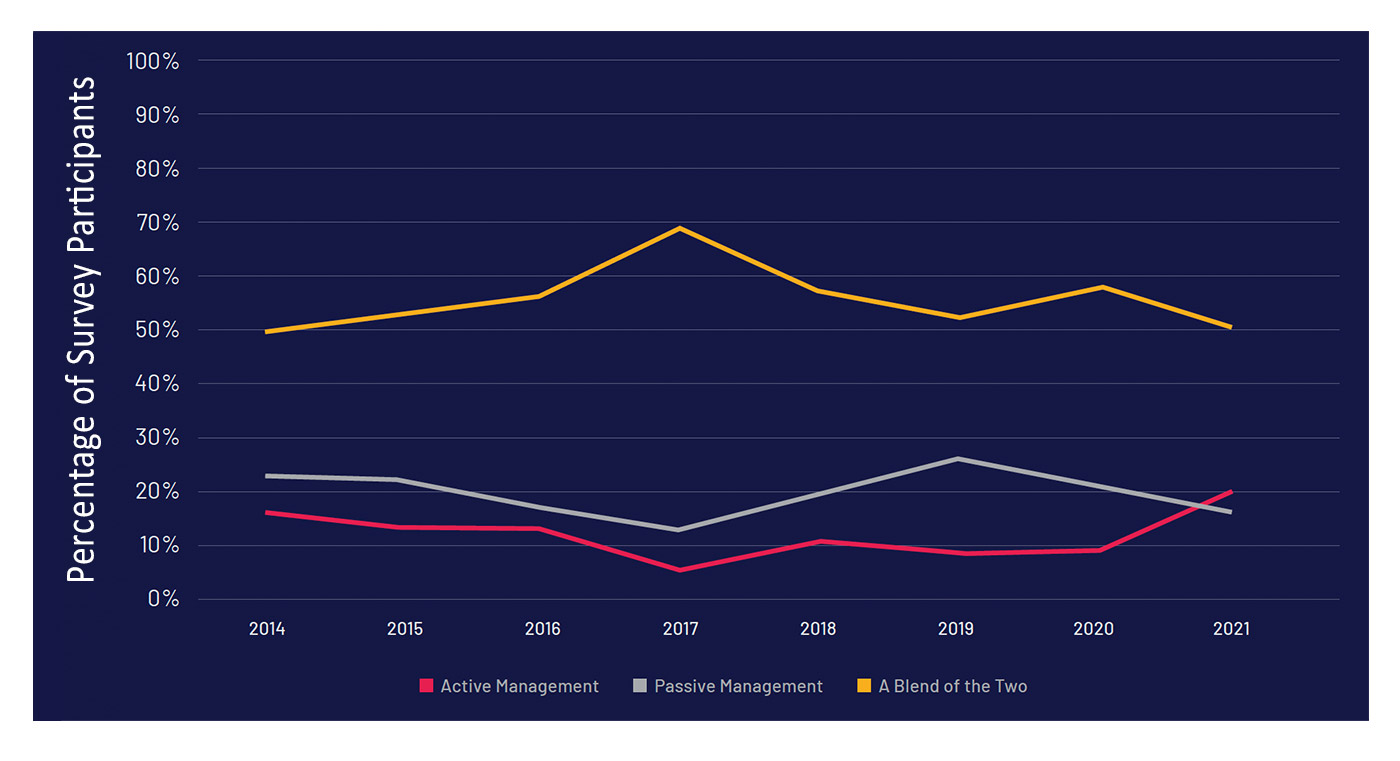The ascendancy of active risk management?
The ascendancy of active risk management?

In addition to the broad performance story of 2020, financial advisors cite many benefits to an investment approach incorporating dynamically risk-managed strategies.
I have interviewed a few different advisory teams for Proactive Advisor Magazine in 2021 that are relatively new to the world of managed accounts, dynamically risk-managed strategies, and the overall philosophy of holistic active portfolio management. (For the sake of simplicity, I have mainly paraphrased their comments here.)
Their somewhat slow and deliberate approach to introducing risk-managed strategies to their clients’ accounts over several years, they say, has accelerated in 2021—largely based on the performance they witnessed in 2020 and how these strategies, in the words of one advisor, “did almost exactly what they were supposed to do.”
Although they have performed due diligence on many third-party investment managers, they happen to be allocating a good portion of their clients’ accounts to rules-based and algorithm-driven strategies. These strategies are largely designed to adapt to changes in the overall market environment and the relative strength and weakness of different asset classes and sectors. These advisors are mainly specialists in retirement-income planning and use such strategies for both qualified and nonqualified client money.
They spoke about how pleased they and their clients were with the implementation of a strategic approach that mitigated the worst of portfolio losses during the pandemic-induced market downturn in 2020 and the very competitive returns achieved for all of 2020.
This type of performance was discussed in the article “Why 2020 is a rare chance to judge your active manager’s performance.” In case you missed it, it is well worth reading.
Aside from the broad performance story these advisors witnessed in 2020, they see many benefits to an investment approach incorporating dynamically risk-managed strategies.
For their clients who are near or in retirement, they say that protection strategies and risk management are often the number one priority they discuss in reviewing clients’ financial and investment-planning needs. They note that the behavioral/emotional benefits of having an investment approach that gives clients a greater level of comfort are significant and can help clients stay committed to their plans—a real win-win for the advisor and the client.
They also say that they offer a lot of education about sequence-of-returns risk, which is a new concept for many of their clients. This becomes far more important for clients as they enter the distribution phase of their retirement plan, and it becomes a pretty clear argument between what one advisor characterized as “rolling the dice with a passive approach versus actively managing the risk.”
They also particularly like the incorporation of noncorrelated strategies and alternative asset classes in an overall risk-managed approach. They discuss the merits of a higher level of diversification with clients versus the more traditional approaches of the past, which they believe do not deal well with periods of market dislocation.
They do not entirely disregard passive or indexed strategies, saying that both active and passive may have a valid long-term strategic role in a portfolio. They often develop a blended approach that depends on each client’s risk tolerance, plan objectives, tax situation, time horizon, and income needs.
However, for many clients, the emphasis is on actively risk-managed strategies, which are uniquely suited to making adjustments based on what is going on in both the markets and the economy. One advisor said, “Today’s market environment and volatility make it difficult with passive investments to avoid downturns or make money in sideways markets.” As a group, they particularly appreciate the fact that sophisticated managed-money approaches are available to clients at a far more competitive fee structure than in the past.
Following the 2007–2009 financial crisis, many advisors turned to fee-based managed accounts, seeking out a new, actively risk-managed portfolio approach for their clients. After two 50% drawdowns for passive strategies in a relatively short period (-49.1% in 2000–2002 for the S&P 500 and -56.8% in 2007–2009, according to Yardeni Research), financial advisors not surprisingly experienced a high degree of client dissatisfaction, a reluctance to recommit to equity markets on the part of clients, and (unfortunately) client defections.
Many advisors who “found” a new risk-managed investment approach following the financial crisis were very satisfied with both the performance and behavioral benefits for their clients. But, as the bull market marched on, very low-cost index funds grew in popularity again, making it more challenging to convince additional advisors to incorporate an actively risk-managed approach for client portfolios. From a behavioral finance perspective, it was a case of “recency bias” for many advisors, where there were short memories about the ever-present risk that lurks for passive investors.
That pendulum has started to swing the other way again, influenced in no small degree by 2020’s roller-coaster market volatility.
According to a SmartAsset survey conducted in March 2021, 42% of advisors cited stock market volatility as the number one reason clients reached out to them over the prior year. A study conducted by The Journal of Financial Planning and the Financial Planning Association (FPA) showed that 76% of advisors’ clients actively contacted them about market volatility in 2020, and 52% have done so in 2021.
The net effect of this, according to that same FPA study, has been a shift toward considering different portfolio approaches. In the March 2021 study, 74% of advisors said they had reevaluated the asset allocation they typically recommend or implement within the prior three-month period. This was largely driven by concerns about the state of the economy and/or market volatility experienced over the prior year.
The study concluded, “The majority of advisers (58 percent) continue to favor a blend of active and passive management, as has been the trend for the past several years. However, the 2021 results show a continued decline in a purely passive approach.”
WHICH TYPE OF MANAGEMENT DO YOU THINK PROVIDES THE BEST OVERALL INVESTMENT PERFORMANCE (TAKING INTO CONSIDERATION ASSOCIATED COSTS)?

Source: 2021 Trends in Investing Survey, conducted by The Journal of Financial Planning and the Financial Planning Association (FPA), March 2021.
In general, financial advisors we have interviewed tell us that third-party money management provides several benefits for their practice and their clients:
- Enhanced risk management/diversification.
- Mitigation of market volatility.
- Sophisticated, rules-based strategies that take emotion out of the investment equation.
- A turnkey approach to strategy implementation and execution.
- Professional investment management that frees up their time for client planning and service.
Specific to the benefits of active portfolio management, one senior financial advisor put it particularly well: “It is my belief and experience that clients are far more willing to stick with an investment plan if a significant percentage of their portfolio incorporates active, or tactical, risk-managed strategies.”
That alone is a very good reason for the expected continued ascendancy of active risk management.
 David Wismer is editor of Proactive Advisor Magazine. Mr. Wismer has deep experience in the communications field and content/editorial development. He has worked across many financial-services categories, including asset management, banking, insurance, financial media, exchange-traded products, and wealth management.
David Wismer is editor of Proactive Advisor Magazine. Mr. Wismer has deep experience in the communications field and content/editorial development. He has worked across many financial-services categories, including asset management, banking, insurance, financial media, exchange-traded products, and wealth management.
